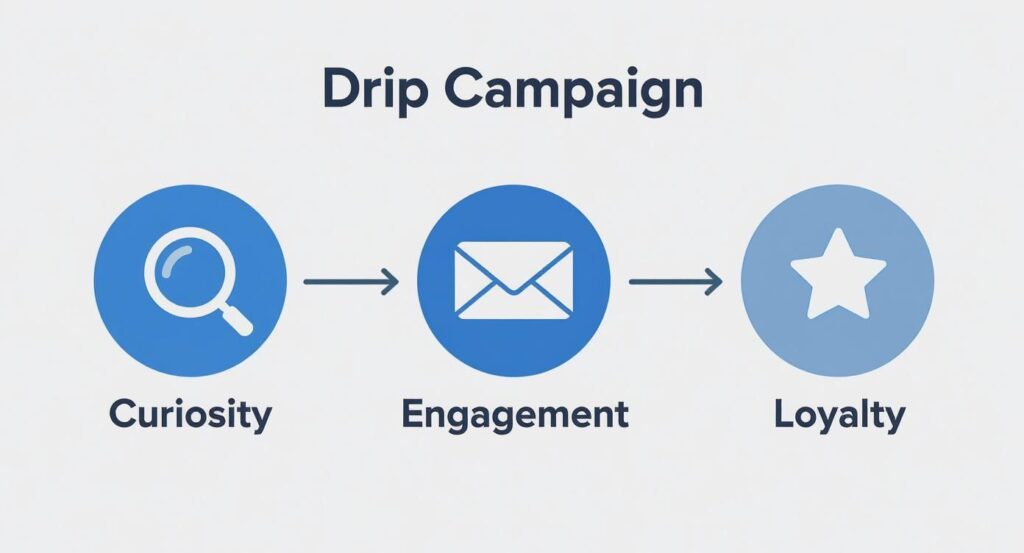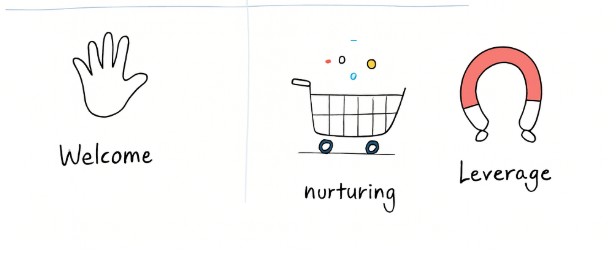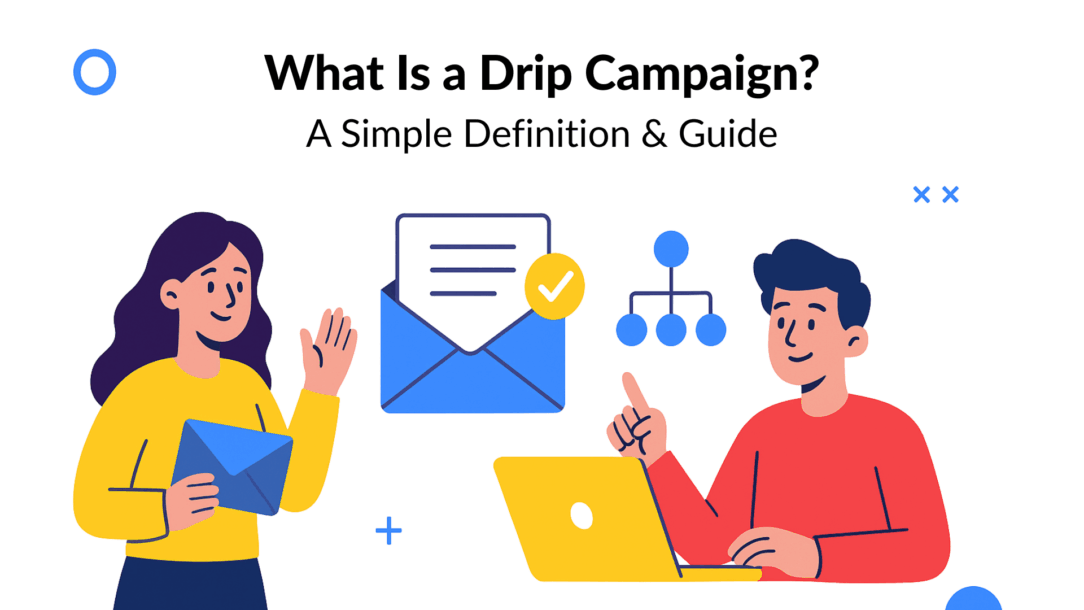A drip campaign is an automated email sequence of messages sent to prospects or customers over time. But that’s just the textbook definition.
Think of it as your best salesperson working 24/7—sending the right drip email at the right time to warm up leads, onboard new users, or win back past customers. It’s an automated system designed to build relationships and drive action, powered by your email marketing software.
What a Drip Campaign Really Means for Your Business
Ever used a drip coffee maker? You don’t dump all the hot water on the grounds at once—it would make a mess and ruin the flavor. Instead, you let it drip slowly, one drop at a time, for the richest brew.
A drip marketing campaign works the same way. Instead of blasting your audience with a one-off email campaign, you deliver small, valuable bits of content over time. This slow-and-steady approach builds trust, nurtures leads, and strengthens relationships without overwhelming your audience.
This isn’t about spamming inboxes—it’s a smart, automated conversation triggered by specific user actions, like signing up for a newsletter or downloading a guide. Each email drip in the sequence is a calculated step that moves someone from mild interest to genuine commitment.
Drip Campaign Core Concepts at a Glance
To really understand how a drip email campaign works, it helps to break down its key components. The table below outlines what makes a drip sequence effective, along with real-world applications.
| Concept | What It Means for Your Marketing | Real-World Use Case |
|---|---|---|
| Automation | Messages are sent automatically—set it up once, and it runs 24/7 without manual work. | A new subscriber instantly receives a welcome email drip without you lifting a finger. |
| Sequencing | Messages are delivered in a specific, logical order to build a narrative. | A 5-day email sequence where each message builds on the last to guide users toward a purchase. |
| Triggers | The sequence starts based on a user’s action (e.g., webinar sign-up) or a set schedule. | Someone abandons their shopping cart, triggering a drip sequence of personalized reminders. |
| Personalization | Each message feels personal and relevant, tailored using user data. | An email drip campaign begins with “Hi [First Name], here are the resources you requested on [Topic].” |
| Nurturing | Builds relationships over time rather than pushing for a one-time sale. | Sharing helpful tips, case studies, and insights over several weeks to build trust. |
This system goes far beyond basic email campaigns. It creates consistent, relevant communication that transforms how you connect with your audience.
Why This Method Is So Effective
The real magic of a drip marketing campaign lies in consistency. By showing up in someone’s inbox regularly with valuable, helpful content, you stay top-of-mind without becoming intrusive.
This automated nurturing process is also incredibly efficient—it frees your team to focus on strategy rather than manual follow-ups. A well-crafted email drip campaign is like having the perfect salesperson who never forgets to follow up, always says the right thing, and works tirelessly to turn curiosity into conversion.
And the numbers don’t lie—drip campaigns generate open rates up to 80% higher than standard one-off emails, making them one of the most effective tools in modern email marketing software.
How Drip Campaigns Actually Work
So, what makes a drip marketing campaign tick? The secret lies in the trigger—the event that starts it all.
A trigger could be anything measurable: a newsletter signup, a guide download, or a cart abandonment. That single action tells your email marketing software to launch a prebuilt automation sequence designed to engage and convert.
Once the trigger fires, the email drip begins. Your marketing campaign platform automatically sends a series of messages—spaced over hours, days, or weeks—each designed to build trust, educate, and motivate action.
This turns one small click into a personalized journey that feels one-on-one, even though it’s completely automated.

Drip Campaign
As you can see, this automated flow is all about nurturing a lead through distinct phases without you having to lift a finger.
A trigger isn’t just a starting point; it’s a signal of intent. By understanding what triggers a user, you gain powerful insight into what they want, allowing you to deliver hyper-relevant content at the perfect moment.
This is what separates a generic email blast from a high-performing drip campaign. The whole system is built to react to what your customers do. For small businesses, finding the right marketing automation tool for small business is the first critical step toward building these powerful, trigger-based journeys.
What Drip Marketing Can Actually Do for You
Knowing how drip campaigns work is one thing. Seeing what they can do for your business is another. The real magic isn’t in the theory—it’s in the results: saving time, nurturing better leads, and boosting profitability.
At its core, automation gives you back your most valuable asset: time. Instead of your team getting bogged down in manual follow-ups, a nurture campaign takes over the heavy lifting 24/7. This frees up your best people to focus on strategy, creativity, and building genuine client relationships—not just sending another “just checking in” email.
Nurture Leads into Loyal Customers
Let’s be practical: most leads aren’t ready to buy the moment they discover your brand. That’s where a lead nurturing campaign comes in. Through consistent, relevant communication, it builds trust and educates prospects over time.
Each message in your email marketing campaign is carefully timed and personalized—guiding prospects from awareness to decision without pressure. Combined with smart segmentation, this ensures every lead receives the most relevant information based on their interests, stage, and behavior.
The results speak for themselves: businesses using automated drip systems and nurture campaigns generate 50% more sales-qualified leads at 33% lower cost. Especially in B2B settings, this approach ensures your sales team spends time on leads who are already convinced of your value.
A great nurture campaign doesn’t just send emails—it builds momentum. Each “drip” acts as a gentle nudge, helping prospects move naturally toward the next step in their buying journey.
Scalable Growth Through Automation
Ultimately, this is about sustainable, scalable growth. By automating the critical process of lead nurturing, you’re building a reliable engine that produces consistent results—without adding more to your team’s workload.
Here’s a snapshot of the transformation you can expect:
-
More Efficiency: Automate repetitive communication so your team can focus on creative, high-impact work.
-
Better Lead Quality: Use segmentation and targeted content to educate and qualify leads who are genuinely ready for sales.
-
Higher Engagement: Deliver timely, relevant messages that strengthen relationships and drive conversions.
Real-World Drip Campaign Examples
Theory is great—but seeing lead nurturing campaigns in action is where it all clicks. These automated systems have become the secret weapon behind successful email marketing campaigns for both e-commerce brands and B2B companies, helping them achieve measurable, repeatable growth.

real-world Drip campaign examples
The core idea is simple: deliver the right message at the right moment, automatically. This turns a single interaction, like a sign-up, into a sustained conversation that guides people toward taking the next step.
Let’s break down a few common scenarios where drip campaigns deliver real results. Each one starts with a simple trigger but unlocks a powerful business outcome. To see how these play out, check out these impactful drip marketing examples that are driving serious growth.
Common Drip Campaign Types and Their Goals
The best way to grasp the power of drip marketing is to see how different campaigns solve different business problems. It’s about moving the needle on key metrics, whether that’s welcoming new leads or winning back old customers.
Here’s a quick look at some of the most common types of drip campaigns and what they’re built to do.
| Campaign Type | Primary Goal | Common Triggers | Practical Example |
|---|---|---|---|
| Welcome Series | Onboard new users, build brand trust, and encourage initial engagement. | Subscribing to a newsletter or creating a new account. | A 3-email series introducing your brand’s mission, top resources, and a special first-time offer. |
| B2B Lead Nurturing | Educate prospects about a complex product and guide them toward a sales call. | Downloading a whitepaper, registering for a webinar, or requesting a demo. | After a webinar, attendees get a follow-up with the recording, a related case study, and an invitation to book a one-on-one demo. |
| Abandoned Cart | Recover lost sales by reminding customers about items they left behind. | Adding items to a shopping cart but not completing the checkout process. | An email sent 2 hours after abandonment showing the items left behind, followed by another 24 hours later with a small discount. |
| Re-Engagement | Win back inactive subscribers or customers who haven’t engaged in a while. | A set period of inactivity, such as 90 days without opening an email or logging in. | A “We miss you!” campaign offering a special incentive to customers who haven’t purchased in the last 6 months. |
Each sequence is a strategic, automated conversation working behind the scenes. They build relationships, drive revenue, and make sure no opportunity gets missed.
The power of a great drip campaign lies in its action-oriented nature. It’s not just a series of emails; it’s an automated system designed to move a person from one stage of the customer journey to the next with minimal manual effort.
How to Build Your First Drip Campaign
Alright, let’s move from theory to action. Building your first drip campaign can feel daunting, but it’s really just a series of logical steps. By breaking it down, you can launch a killer automated campaign without getting overwhelmed.

Building your first Drip campaign
The goal is to create a drip email marketing campaign that feels personal and genuinely helpful—guiding people to the next step without being pushy. Let’s walk through the five key stages that make every email drip marketing strategy effective.
1. Define Your Goal and Audience
Before you write a single word, know why you’re building this campaign and who it’s for. A vague goal like “get more sales” won’t cut it. Be clear and specific.
Are you trying to:
-
Welcome new subscribers and give them a warm introduction to your brand?
-
Nurture webinar attendees until they’re ready to book a demo?
-
Re-engage inactive users who haven’t logged in for 90 days?
Your goal is your North Star—it guides every decision, from the trigger you choose to the tone of your drip campaign emails.
2. Choose Your Trigger Event
The trigger is the starting point for your entire email drip sequence. It’s the specific action (or inaction) that automatically enrolls someone into your drip email marketing campaign.
Common triggers include:
-
Behavior-based: Someone subscribes to your newsletter, downloads an ebook, or abandons their cart.
-
Time-based: A certain number of days pass, or an anniversary or renewal date arrives.
Make sure the trigger aligns perfectly with your goal. For example, if you’re running a welcome email drip marketing sequence, the trigger is clear—a new subscription.
3. Map the Customer Journey
Next, map out the path your subscriber will take. How many drip campaign emails will you send, and how far apart should they be? Sending messages too close together can feel spammy, while too much space may break momentum.
A simple welcome journey might look like this:
-
Email 1 (Immediate): Welcome them and deliver what you promised (e.g., a free guide).
-
Email 2 (2 Days Later): Share a success story or short case study.
-
Email 3 (4 Days Later): Address a common pain point and show how you solve it.
-
Email 4 (7 Days Later): Make your offer or include a strong call-to-action (CTA).
This structure helps your email drip sequence flow naturally while building engagement with every step.
4. Write Compelling, Personalized Content
With the journey mapped out, start writing. Every message in your email drip marketing sequence should add value, feel conversational, and end with one clear CTA.
Personalization is crucial—use their first name, reference the action they took (“Thanks for downloading our guide!”), and make every message feel written just for them.
5. Set Up, Test, and Launch
Finally, build the sequence inside your marketing automation tool. Before hitting “go,” send test versions to yourself and a few teammates.
Check for typos, broken links, and formatting errors. Most importantly, test the trigger logic to ensure your drip campaign emails send exactly when they should.
Once everything’s working perfectly, launch your email drip sequence and watch as it nurtures leads, builds trust, and drives conversions—automatically.
To make this even easier, you can integrate ActiveCampaign with Clepher to manage your automations all in one place.
Measuring the Success of Your Drip Campaigns
You’ve launched your drip campaign. Great! But the work isn’t over. To know if it’s making a real difference, you need to track the metrics that prove it’s working. Moving beyond simple open rates is where you start to see the real business impact.
Key performance indicators (KPIs) tell the story of your campaign’s health. By watching them closely, you can see what’s resonating with your audience and what needs improvement.
Key Metrics to Watch
To get the full picture, look at a mix of engagement and conversion data. These numbers give you the actionable insights needed to understand how your automated sequences are performing.
- Click-Through Rate (CTR): This shows how many people clicked a link in your message. It’s a direct measure of how compelling your content and calls-to-action are.
- Conversion Rate: This is the ultimate metric. It tracks how many people completed your goal, whether that’s making a purchase, booking a demo, or signing up.
- Unsubscribe Rate: A high unsubscribe rate is a major red flag. It might mean your content isn’t relevant, or perhaps you’re sending messages too often.
For a deeper look, our guide on the top email marketing KPIs you should track for success offers a complete checklist.
Calculating ROI and Optimizing Performance
At the end of the day, the most important question is: what’s the return on investment (ROI)? By tracking the conversions and sales tied directly to a campaign, you can prove the real business value of your automation efforts.
A/B testing is your secret weapon for continuous improvement. Test one variable at a time—like the subject line, the call-to-action, or the send time. This is how you systematically turn a good campaign into a great one.
This data-driven approach is what separates the campaigns that deliver results from those that don’t. The proof is in the numbers. Research shows brands using drip campaigns can drive 69% more sessions per user compared to other channels, proving their power to keep audiences hooked.
Conclusion
An effective drip campaign is essential for building customer relationships and promoting your business. By utilizing an email automation tool, you can set up a drip email marketing campaign that targets your specific audience. This series of automated marketing emails keeps recipients engaged and ensures they receive relevant content triggered by user actions. The effectiveness of your drip campaign relies on well-crafted email copy and a strategic approach to email marketing. As you implement automated drip campaigns, remember to analyze the results to enhance future campaigns. Drip marketing can help you maintain a connection with your email list, ultimately leading to successful sales and marketing outcomes.
Ready to build, launch, and measure your own powerful drip campaigns? With Clepher, you can design automated conversational flows on your website, Messenger, and Instagram, turning visitors into subscribers and sales. See how our no-code builder can transform your marketing.
Related Posts



